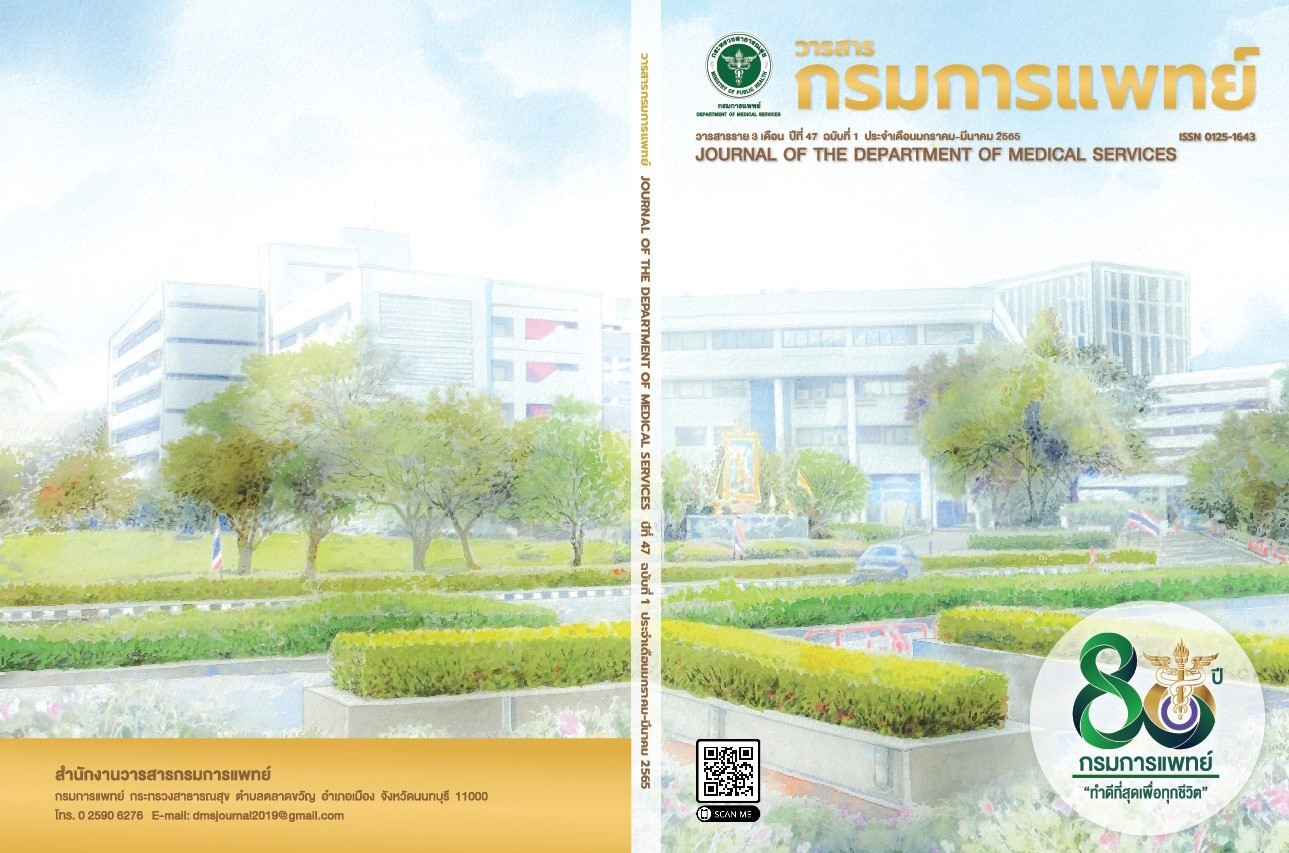Evaluation of fluoride release and recharge of composite resin containing surface pre-reacted glass ionomer fillers (Beautifill II)
Keywords:
Giomer, S-PRG fillers, fluoride release in dental material, resin composite containing S-PRG fillersAbstract
Background: Biomaterials have been developed with the ability of fluoride release for caries prevention. A modified resin composite with surface pre-reacted glass ionomer (S-PRG) fillers would overcome disadvantages of glass-ionomer cement in term of mechanical properties while improve bio-functional characteristics of the resin of fluoride release like glass ionomer cement.Objective: This study aimed to evaluate the effectiveness of fluoride release and recharge from a modified resin composite with surface pre-reacted glass ionomer fillers.Methods: Thirty disc-shaped experimental specimens (8X2 mm in diameter, n=10/group) were prepared from 3 types of materials; resin composite (Filtek™), resin composite containing S-PRG filler (Beautifill II), and glass ionomer cement (Fuji II ® LC). All specimens were kept in dry condition at 37C๐ for 1 hours before soaking in 3 ml of deionized water for 12 hours. Then, all specimens were recharged with 1000 ppm NaF solution for 12 hours before rinsed and soaked in 3 ml of deionized water for a further 24 hours. Amount of fluoride was measured daily for an initial release over 7 days and repeated for 10 cycles of the recharge. The mean fluoride concentration per surface area (μg/cm2) was calculated and analyzed using repeated measure ANOVA at P<0.05, followed by Turkey’s HSD multiple comparison test.Result: Fluoride released from the resin composite containing S-PRG filler showed a significantly higher level of fluoride than that of resin composite but significantly lesser than conventional glass ionomer cement entire periods of initial release and after recharging with 1000 ppm NaF.Conclusion: A modified resin composite with S-PRG filler had capability of initial fluoride release and sustained release after recharge with fluoride regimen. Despite, lower level of fluoride release than conventional glass ionomer cement, it could act as a fluoride reservoir for prevention of caries in oral cavity.
References
Dalli M, Colak H, Mustafa Hamidi M. Minimal intervention concept: a new paradigm for operative dentistry. J Investig Clin Dent. 2012; 3:167-75.
Wiegand A, Buchalla W, Attin T. Review on fluoride-releasing restorative materials--fluoride release and uptake characteristics, antibacterial activity and influence on caries formation. Dent Mater. 2007; 23:343-62.
Rošin-Grget K, Peroš K, Sutej I, Bašić K. The cariostatic mechanisms of fluoride. Acta Med Acad. 2013; 42:179-88.
Mickenautsch S, Yengopal V. Caries-preventive effect of glass ionomer and resin-based fissure sealants on permanent teeth: An update of systematic review evidence. BMC Res Notes. 2011; 4:22.
Benelli EM, Serra MC, Rodrigues AL Jr, Cury JA. In situ anticariogenic potential of glass ionomer cement. Caries Res. 1993; 27:280-4.
Medjedovic E, Medjedovic S, Deljo D, Sukalo A. IMPACT OF FLUORIDE ON DENTAL HEALTH QUALITY. Mater Sociomed. 2015; 27:395-8.
Yardeni J, Hermel J. The Anticariogenic Effect of Sodium Fluoride. J Dent Res. 1969; 48:965.
Lussi A, Hellwig E, Klimek J. Fluorides - mode of action and recommendations for use. Schweiz Monatsschr Zahnmed. 2012; 122:1030-42.
Quader S, Shamsul Alam M, Bashar A, Gafur M, Al-Mansur M. Compressive Strength, Fluoride Release and Recharge of Giomer. Update Dent. Coll. j. 2013; 2, 28-37.
Koontongkaew S. Witthayakan rok fanpu. Bnankok.I-group press. 2009; 2.
Fujimoto Y, Iwasa M, Murayama R, Miyazaki M, Nagafuji A, Nakatsuka T. Detection of ions released from S-PRG fillers and their modulation effect. Dent Mater J. 2010; 29:392-7.
Colceriu Burtea L, Prejmerean C, Prodan D, Baldea I, Vlassa M, Filip M, et al. New Pre-reacted Glass Containing Dental Composites (giomers) with Improved Fluoride Release and Biocompatibility. Materials (Basel). 2019; 12:4021.
Cefaly DF, de Mello LL, Wang L, Lauris JR, D’Alpino PH. Effect of light curing unit on resin-modified glass-ionomer cements: a microhardness assessment. J Appl Oral Sci. 2009; 17:150-4.
Itota T, Carrick TE, Yoshiyama M, McCabe JF. Fluoride release and recharge in giomer, compomer and resin composite. Dent Mater. 2004; 20:789-95.
Ikemura K, Tay FR, Endo T, Pashley DH. A Review of Chemicalapproach and Ultramorphological Studies on the Development of Fluoride-releasing Dental Adhesives Comprising New Pre-Reacted Glass Ionomer (PRG) Fillers. Dent Mater J. 2008; 27:315-39.
Kurokawa H, Takamizawa T, Rikuta A, Tsubota K, Miyazaki M. Three-year clinical evaluation of posterior composite restorations placed with a single-step self-etch adhesive. J Oral Sci. 2015; 57:101-8.
Wakamatsu N, Ogika M, Okano T, Murabayashi C, Kondo T, Linuma M. Effect of tooth surface coating material containing S-PRG filler on white spot lesions of young permanent teeth. Pediatr Dent J. 2018; 28: 40-5.
Saku S, Kotake H, Scougall-Vilchis RJ, Ohashi S, Hotta M, Horiuchi S, et al. Antibacterial activity of composite resin with glassionomer filler particles. Dent Mater J. 2010; 29:193-8.
Naoum S, Ellakwa A, Martin F, Swain M. Fluoride release, recharge and mechanical property stability of various fluoride-containing resin composites. Oper Dent. 2011; 36:422-32.
Mousavinasab SM, Meyers I. Fluoride release by glass ionomer cements, compomer and giomer. Dent Res J (Isfahan). 2009; 6:75-81.
Akimoto N, Ohmori K, Hanabusa M, Monoi Y. An eighteen-month clinical evaluation of posterior restorations with fluoride releasing adhesive and composite systems. Dent Mater J. 2011; 30:411-8.
Itota T, Carrick TE, Rusby S, Al-Naimi OT, Yoshiyama M, McCabe JF. Determination of fluoride ions released from resin-based dental material using ion-selective electrode and ion chromatograph. J Dent. 2004; 32:117-22.
Meurman JH, Hemmerle J, Voegel JC, Rauhamaa-Mäkinen R, Luomanen M. Transformation of hydroxyapatite to fluorapatite by irradiation with high-energy CO2 laser. Caries Res. 1997; 31:397-400.
Downloads
Published
How to Cite
Issue
Section
License
Copyright (c) 2022 Department of Medical Services, Ministry of Public Health

This work is licensed under a Creative Commons Attribution-NonCommercial-NoDerivatives 4.0 International License.
บทความที่ได้รับการตีพิมพ์เป็นลิขสิทธิ์ของกรมการแพทย์ กระทรวงสาธารณสุข
ข้อความและข้อคิดเห็นต่างๆ เป็นของผู้เขียนบทความ ไม่ใช่ความเห็นของกองบรรณาธิการหรือของวารสารกรมการแพทย์



